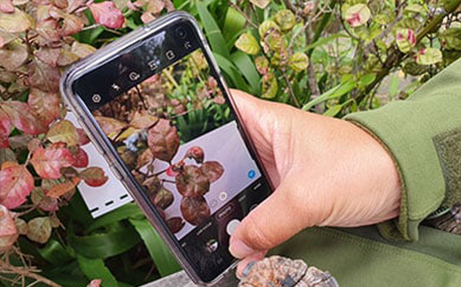What to do if you find myrtle rust
At present, there is no cure for myrtle rust. Removing plants from your garden helps reduce the spread of the disease to other uninfected myrtles and our nearby forests. Reporting the disease through iNaturalist helps track the disease.
How to report myrtle rust
Reporting sightings of myrtle rust is vital in helping scientists and agencies track the spread of the disease and its impact on New Zealand.
If you think you see the symptoms of myrtle rust:
- take a clear in-focus photograph of the whole plant, the affected leaf, and a close-up of the spores
- submit the photograph to Myrtle Rust Reporter - iNaturalist website
Make sure you label your finds as myrtle rust, noting what host plant it has been found on. Capturing this information through iNaturalist means it will be available in future to analyse the rate of spread and observed impacts.
If you see myrtle rust on public land you can report your myrtle rust sighting to:
- your local council
- the Department of Conservation (DOC) if sighted on public conservation land.
For other myrtle rust queries, contact the Ministry for Primary Industries (MPI). Including reports of:
- New host species
- Movements of infected plants
To connect with MPI regarding myrtle rust email MyrtlerustNZ@mpi.govt.nz
Remember, don't try to collect samples as this may increase the spread of the disease.
How to remove infected myrtle plants
If you find myrtle rust on your property, consider removing the infected plant.
There is no requirement for landowners to remove plants with myrtle rust – it's your choice. However, removing infected plants can help protect other plants in your garden and wider local area.
For larger trees or hedges, consider using a professional arborist. Let them know that you suspect myrtle rust.
For small shrubs and branches, follow the disposal protocol in the video below.
Video – How to remove infected shrubs and branches, step by step (2.23)
Note: use of hairspray is no longer required.
A summary of the process is available in our guidance document.
How to remove infected myrtle plants and safely dispose of the waste [PDF, 1MB]
Further advice on helping reduce the spread
 Arrive clean, leave clean
Arrive clean, leave clean
The forest you visit could be infected with myrtle rust without you knowing it. Before entering such areas for work or recreation, you should minimise the risk of spreading the rust by ensuring your equipment, clothing, and tools arrive clean and leave the area clean.
 Avoid removing the material on windy days
Avoid removing the material on windy days
Try to remove infected material on wet days. This will reduce the risk of cloud of spores being spread to other plants.
 Bury or bag
Bury or bag
Dispose of infected plant waste by burying at the site, or putting in plastic bags and taking to general waste. Do not burn infected plant waste as the spores will travel and spread to new areas with the smoke.
 Fungicide sprays
Fungicide sprays
Fungicide sprays are an option for controlling myrtle rust, but should be used sparingly and with caution. Remember there is no cure for myrtle rust, fungicides can only help reduce infection and spore production and needs to be used frequently to be effective.
Advice for Myrtle Rust Removal (Fungicides)
 Buy healthy plants and prune in cool weather
Buy healthy plants and prune in cool weather
Make sure myrtle plants bought for your garden are free from the symptoms of myrtle rust. Inspect the leaves and stems of plants before you buy them, and avoid buying plants that have signs of disease.
We recommend avoiding heavy pruning during warm weather as this will encourage susceptible new growth. Instead, prune myrtles only in late autumn and early winter to avoid encouraging new growth during warm weather when myrtle rust spores are more likely to form.
 Monitor your plants
Monitor your plants
We recommend regular monitoring of myrtle plants for any sign of myrtle rust, particularly new, young growth, shoots, and seedlings.